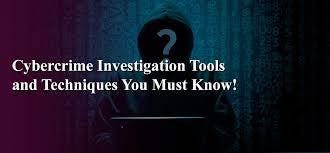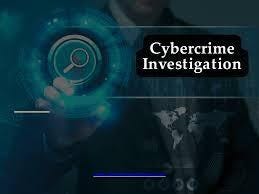
In an increasingly digital world where every aspect of modern life — from communication and commerce to healthcare and governance — is mediated through cyberspace, the incidence and complexity of cybercrime have escalated exponentially, demanding equally sophisticated and multilayered investigative strategies from law enforcement and cybersecurity experts alike; cybercrime, an umbrella term encompassing a broad array of illicit activities including hacking, identity theft, financial fraud, cyberstalking, child exploitation, cyberterrorism, and the dissemination of malware or ransomware, represents not only a direct threat to individual victims but also a systemic danger to the integrity of institutions and national security frameworks; as such, cybercrime investigation has evolved into a hybridized discipline that merges traditional investigative techniques with digital forensics, behavioral analytics, and international law, creating a complex and dynamic ecosystem where speed, precision, and adaptability are critical; the initial phase of any cybercrime investigation often begins with the identification and reporting of suspicious activities — be it unusual login attempts, unauthorized financial transactions, phishing emails, or breaches in firewalls — followed by the collection of digital evidence through techniques such as live data acquisition, disk imaging, packet sniffing, and memory forensics, ensuring the integrity of data via hash verification and meticulous chain-of-custody protocols to meet evidentiary standards in legal proceedings; these evidentiary artifacts, which may include server logs, IP addresses, metadata, encrypted files, browser histories, or even fragments of deleted data, are analyzed using tools like EnCase, FTK, X-Ways, and Autopsy, while reverse engineering is employed to dissect and understand malicious code, trace its origin, and potentially uncover vulnerabilities in the exploited systems; meanwhile, investigators often employ OSINT (Open Source Intelligence), threat intelligence platforms, and collaboration with Internet Service Providers (ISPs) to track down anonymized offenders who frequently utilize Virtual Private Networks (VPNs), proxy chains, the Tor network, and copyright to obfuscate their identities and transactions; attribution, one of the most challenging aspects of cybercrime investigation, is complicated by jurisdictional boundaries, the decentralized nature of the Internet, and the use of botnets and spoofed IP addresses to mislead and delay authorities; to counter this, cybersecurity units rely on behavioral analytics, pattern recognition, and even artificial intelligence to correlate seemingly disparate events, while building digital profiles of offenders that include their online habits, preferred tools, linguistic markers, and even time-zone activity patterns; a critical component of modern cybercrime investigations is international cooperation, as many cybercrimes involve transnational actors operating from countries with limited or non-existent extradition treaties; frameworks such as the Budapest Convention on Cybercrime, INTERPOL’s Cybercrime Directorate, and the Joint Cybercrime Action Taskforce (J-CAT) facilitate collaborative investigations, intelligence sharing, and coordinated take-downs of global cybercriminal infrastructures like dark web marketplaces or ransomware-as-a-service (RaaS) operations; private sector actors, especially tech companies, cybersecurity vendors, and financial institutions, also play a vital role in supporting investigations through incident reporting, threat mitigation, and forensic assistance; another indispensable ally is the ethical hacking community — white-hat hackers who participate in bug bounty programs or assist law enforcement in tracking vulnerabilities and locating hidden threat actors; educational institutions and training bodies have also responded to the growing demand for cybercrime specialists by developing courses in cyber law, ethical hacking, digital forensics, and cyber threat intelligence, thereby contributing to a new generation of investigators equipped with both technical acumen and legal awareness; courts, too, have had to adapt by developing cyber-specific legal procedures and training judges to understand digital evidence and the technological nuances of cybercrime prosecution, especially in cases involving minors, cross-border data, or complex financial fraud; certain forms of cybercrime, such as ransomware attacks, require negotiation and crisis management skills in addition to technical expertise, as victims — often critical infrastructure providers like hospitals or municipal governments — must decide whether to pay ransoms, work with law enforcement, or attempt to recover data independently; in such high-stakes scenarios, cyber insurance firms, public relations consultants, and incident response teams become involved, further expanding the interdisciplinary scope of cybercrime investigation; within law enforcement, agencies such as the FBI’s Cyber Division, copyright’s EC3, and national CERTs (Computer Emergency Response Teams) have become key players, employing cybersecurity specialists, linguists, legal advisors, and behavioral scientists to tackle threats ranging from lone-wolf hackers to state-sponsored Advanced Persistent Threats (APTs); social media platforms, often exploited for cyberbullying, doxing, and dissemination of disinformation, are another investigative frontier requiring collaboration between tech giants and legal authorities to ensure that content moderation policies align with criminal statutes and user privacy protections; as cybercriminals become more innovative — employing AI-generated deepfakes, autonomous attack scripts, and machine learning algorithms to adapt to defenses — the response must be equally agile, with real-time threat detection, proactive security policies, zero-trust architectures, and continuous monitoring of endpoints, user behaviors, and network flows; yet, despite all advancements, the human factor remains both the greatest vulnerability and most potent investigative asset — insider threats, social engineering, and negligent user behavior are common entry points for cybercriminals, while whistleblowers, informants, and cooperative witnesses often provide the breakthroughs needed to crack complex cases; public awareness campaigns, cybersecurity drills, and digital hygiene education remain essential for prevention, particularly in schools, businesses, and government organizations that are prime targets for espionage, financial theft, or data exfiltration; as cybercrime continues to evolve, so must the tools and tactics used to investigate and combat it, calling for continuous innovation, interdisciplinary collaboration, and an unwavering commitment to upholding justice, security, and digital trust in an increasingly interconnected and vulnerable world.
In an era dominated by digital transformation, where everything from banking and healthcare to education and governance depends on digital infrastructure, the rise in cybercrime has become one of the most pressing global challenges. Cybercrime encompasses a wide range of malicious activities carried out through digital means, including hacking, identity theft, cyberbullying, cyberterrorism, financial fraud, online harassment, and the distribution of malware or ransomware. These crimes target not only individuals but also corporations, governments, and critical infrastructure, making the consequences potentially devastating. As the threat landscape continues to evolve, cybercrime investigation has become a multidisciplinary effort, blending traditional policing methods with advanced technological tools and international collaboration to track, apprehend, and prosecute cybercriminals.
The cybercrime investigation process typically begins when an incident is reported or detected — either by a victim, a security system alert, or during routine surveillance by cybersecurity professionals. Once an attack is identified, investigators must act swiftly to collect digital evidence while preserving the integrity of the data. This evidence may include system logs, IP addresses, emails, social media interactions, deleted files, browser histories, and malware samples. Tools such as EnCase, FTK (Forensic Toolkit), X-Ways, and Autopsy are widely used in the digital forensics community to retrieve, analyze, and document such evidence. Investigators also make use of volatile data such as RAM dumps and network traffic captures using techniques like packet sniffing and memory forensics to reconstruct the timeline and method of the attack.
A critical phase of cybercrime investigation is the attribution of the crime — that is, identifying the person or group responsible. This process is often the most challenging due to the anonymous nature of the internet, the use of encryption, and tools like VPNs, Tor, proxy servers, and botnets that mask identities. Cybercriminals often operate across multiple jurisdictions, further complicating the process. Investigators use techniques such as OSINT (Open Source Intelligence), behavioral analytics, geolocation tracking, time-zone correlation, and even linguistic pattern recognition to help pinpoint suspects. In some cases, law enforcement must coordinate with ISPs, cloud service providers, and tech companies to trace digital footprints and access server data stored in other countries.

International cooperation is essential in cybercrime investigations, especially since many crimes involve actors from multiple nations. Agreements like the Budapest Convention on Cybercrime and partnerships through INTERPOL, copyright, and the Joint Cybercrime Action Taskforce (J-CAT) have made significant strides in facilitating cross-border information sharing and collaborative operations. These alliances enable the synchronized takedown of cybercriminal networks, the seizure of illegal assets, and the disruption of dark web marketplaces involved in trafficking drugs, weapons, stolen data, and child exploitation materials. Furthermore, intelligence-sharing platforms help countries stay informed about emerging threats and evolving tactics used by cybercriminal groups.
The role of ethical hackers — often referred to as white-hat hackers — is another key component in modern cybercrime defense and investigation. These professionals simulate cyberattacks to test system vulnerabilities and sometimes assist in real-time investigations. Through bug bounty programs and threat-hunting initiatives, white-hat hackers provide insights that help secure software, identify weaknesses, and expose threat actors before they cause damage. Organizations also rely heavily on Cyber Threat Intelligence (CTI) teams, who constantly monitor digital environments for indicators of compromise (IOCs), track malware signatures, and predict emerging attack trends using artificial intelligence and machine learning algorithms.
Cybercrime investigations are also heavily reliant on the legal system, which must adapt to keep up with the pace of technological change. Prosecuting cybercriminals involves presenting digital evidence that complies with legal standards for admissibility. Investigators must ensure a documented chain of custody, data integrity, and clear demonstration of how evidence was collected and analyzed. Courts now employ technical experts and digital evidence officers, and judges receive specialized training to interpret forensic data. Certain crimes, such as online exploitation or large-scale data breaches, require cross-agency task forces composed of prosecutors, victim advocates, digital forensic analysts, and law enforcement.
Certain types of cybercrime, such as ransomware attacks, demand a unique and immediate response. In these attacks, hackers encrypt a victim’s data and demand payment — often in copyright — in exchange for decryption keys. Organizations facing ransomware incidents must decide whether to negotiate, involve law enforcement, or attempt data recovery independently. In such high-pressure scenarios, incident response teams, crisis communication experts, cyber insurance providers, and forensic investigators all play vital roles. The ability to respond quickly and decisively can mean the difference between a successful recovery and a catastrophic loss of data, funds, and public trust.

Social media platforms and mobile apps are increasingly being used for cyberbullying, harassment, scams, doxing, and disinformation campaigns. These cases require coordination between investigators and platform providers to retrieve user data, remove harmful content, and prevent future abuse. The enforcement of community standards, digital privacy laws, and data retention policies becomes particularly important in these contexts. In addition, investigations involving minors require special legal considerations, including consent, safeguarding, and psychological support for victims. Law enforcement must navigate a fine line between collecting evidence and respecting privacy, particularly in countries with stringent data protection regulations like the EU’s GDPR.
The private sector plays a significant role in both preventing and investigating cybercrime. Financial institutions, technology companies, e-commerce platforms, and healthcare providers all collect vast amounts of sensitive data and are common targets for attacks. These organizations often have internal cybersecurity teams trained to detect, isolate, and mitigate threats. In many cases, they collaborate directly with law enforcement, sharing logs, incident reports, and technical data to support investigations. Cybersecurity companies also offer forensic services, managed detection and response (MDR), and advanced monitoring solutions that assist in post-attack analysis and threat intelligence gathering.
Training and education are key to preparing the next generation of cybercrime investigators. Universities and training institutions offer certifications and degree programs in digital forensics, cybersecurity law, ethical hacking, and cyber threat intelligence. Organizations like CompTIA, EC-Council, and SANS Institute provide specialized credentials such as CEH (Certified Ethical Hacker), CHFI (Computer Hacking Forensic Investigator), and GCFA (GIAC Certified Forensic Analyst). These certifications equip professionals with the skills needed to conduct investigations, write forensic reports, and testify in court as expert witnesses. Additionally, continuous professional development is critical, as cyber threats evolve faster than traditional policing models.

Prevention remains a cornerstone of cybercrime defense. Public awareness campaigns, cybersecurity drills, phishing simulations, and employee training all help reduce the human errors that often lead to breaches. Individuals and organizations are encouraged to use strong passwords, enable multi-factor authentication, keep software updated, and remain vigilant against social engineering tactics. Governments and nonprofits run national awareness programs during events like Cybersecurity Awareness Month, emphasizing digital hygiene and safe online behavior. These preventive measures reduce the attack surface and improve resilience against potential threats.
As we move deeper into the digital age, the cybercrime landscape will continue to shift, driven by technological innovation, geopolitical tensions, and socioeconomic change. Threats like deepfake technology, autonomous attack systems, synthetic identities, and quantum-enabled hacking loom on the horizon. To counter these future threats, cybercrime investigation must remain proactive, agile, and deeply collaborative. This means investing in emerging technologies, building global coalitions, standardizing legal frameworks, and ensuring that investigators are equipped with both technical and ethical training. Ultimately, the fight against cybercrime is not just about catching criminals — it’s about safeguarding trust, privacy, and the foundational security of our interconnected world.
Comments on “Inside the Digital Battlefield: A-Word Deep Dive into Cybercrime Investigation”